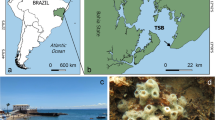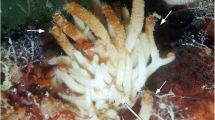Abstract
The sponge Tetilla sp. (Tetractinomorpha: Tetillidae) is a common species in the eastern Mediterranean. This sponge inhabits four different habitat types differing in wave impact and irradiance levels. Two of these habitats (a shallow cave and deep water) are characterized by relatively calm water, whereas the other two (shallow exposed site and tide pools) are in turbulent water with high energy flow. The present study examined the influence of physical (depth, illumination and water motion) and biotic factors on morphology, skeletal plasticity and reproductive traits among the four spatially separated populations. Sponges from tidal pools had significantly larger body volume than sponges from deep water and from shallow caves (ANOVA: tidal-deep P<0.0001; tidal-shallow caves P<0.05). Sponges from exposed habitats were significantly larger than deep-water sponges (ANOVA: P=0.01). In addition, individuals from tide pools and from the exposed habitat had a significantly higher proportion of structural silica than sponges from the calmer deep water and from the cave sites. Oxea spicules in sponges from the calm habitats were significantly shorter than in those from the tidal pools and the exposed habitats. The percentage of spicules out of a sponge’s dry weight in individuals transplanted from deep (calm) to shallow (turbulent) water significantly increased by 21.9±12.9%. The new spicule percentage did not differ significantly from that of sponges originally from shallow water. Oocyte diameter differed significantly between habitats. The maximal size of mature eggs was found in deep-water sponges in June (97±5 μm). In the shallow habitats, a smaller maximal oocyte diameter was found in the cave, in May (56.5±3 μm). Furthermore, oocyte density in shallow-water sponges was highest in May and decreased in June (with 88.2±9 and 19.3±9 oocytes mm−2, respectively). At the same time (June), oocyte density of deep-water sponges had just reached its maximum (155±33.7 oocytes mm−2). The difference in oocyte size and density between deep- and shallow-water individuals indicates an earlier gamete release in the shallow sponge population. The results suggest that plasticity in skeletal design of this sponge indicates a trade off between spicule production and investment in reproduction.





Similar content being viewed by others
References
Alvarez B, Diaz MC, Laughlin RA (1990) The sponge fauna on a fringing coral reef in Venezuela. I. Composition, distribution and abundance. In: Rützler K (ed) New perspectives in sponge biology. Smithsonian Institution Press, Washington DC, pp 358–366
Babcock RC, Bull GD, Harrison PL, Heyward AJ, Oliver JK, Wallace CC, Willis BL (1986) Synchronous spawning of 105 scleractinian coral species on the Great Barrier Reef. Mar Biol 90:379–394
Bavestrello G, Bonito M, Sara M (1993) Influence of depth on the size of sponge spicules. Sci Mar 57:415–420
Becerro MA, Uriz MJ, Turon X (1994) Trends in space occupation by the encrusting sponge Crambe crambe—variation in shape as a function of size and environment. Mar Biol 12:301–307
Becerro MA, Uriz MJ, Turon X (1997) Chemically-mediated interactions in benthic organisms: the chemical ecology of Crambe crambe (Porifera, Poecilosclerida). Hydrobiologia 355:77–89
Bell JJ, Barnes DKA (2000) The influences of bathymetry and flow regime upon the morphology of sublittoral sponge communities. J Mar Biol Assoc UK 80:707–718
Bell JJ, Barnes DKA, Turner JR (2002) The importance of micro- and macro-morphological variation in the adaptation of a sublittoral demosponge to current extremes. Mar Biol 140:75–81
Diaz MC, Alvarez B, Laughlin RA (1990) The sponge fauna on a fringing coral reef in Venezuela. II. Community structure. In: Rützler K (ed) New perspectives in sponge biology. Smithsonian Institution Press, Washington DC, pp 367–375
Doty MS (1971) Measurement of water movement in reference to benthic algal growth. Bot Mar 14:4–7
Fan TY, Dai CF (1995) Reproductive ecology of the scleractinian coral Echinopora lamellosa in northern and southern Taiwan. Mar Biol 123:565–572
Fan TY, Dai CF (1999) Reproductive plasticity in the reef coral Echinopora lamellosa. Mar Ecol Prog Ser 190:297–301
Frøhlich H, Barthel D (1997) Silica uptake of the marine sponge Halichondria panicea in Kiel Bight. Mar Biol 128:115–125
Fromont J (1994) Reproductive development and timing of tropical sponges (Order Haplosclerida) from the Great Barrier Reef, Australia. Coral Reefs 13:127–133
Fry WG (1970) The sponge as a population: a biometric approach. In: The biology of the Porifera. Proc Zool Soc Lond 25:135–161
Hill MS, Hill AL (2002) Morphological plasticity in the tropical sponge Anthosigmella varians: response to predators and wave energy. Biol Bull (Woods Hole) 202:86–95
Ilan M, Loya Y (1990) Sexual reproduction and settlement of the coral reef sponge Chalinula sp. from the Red Sea. Mar Biol 105:25–31
Jokiel PL, Morrissey JI (1993) Water motion on coral reefs: evaluation of the ‘clod card’ technique. Mar Ecol Prog Ser 93:175–181
Kaandorp JA (1999) Morphological analysis of growth forms of branching marine sessile organisms along environmental gradients. Mar Biol 134:295–306
Koehl MAR (1982) Mechanical design of spicule-reinforced connective tissue: stiffness. J Exp Biol 98:239–267
Manconi R, Pronzato R (1991) Life cycle of Spongilla lacustris (Porifera, Spongillidae): a cue for environment-dependent phenotype. Hydrobiologia 220:155–160
McDonald JI, Hooper JNA, McGuinness KA (2002) Environmentally influenced variability in the morphology of Cinachyrella australiensis (Carter, 1886) (Porifera: Spirophorida: Tetillidae). Mar Freshw Res 53:79–84
Meroz-Fine E, Ilan M (1995) Life history characteristics of a coral reef sponge. Mar Biol 124:443–451
Paine RT (1964) Ash and calorie determinations of sponge and opisthobranch tissues. Ecology 45:384–387
Palumbi SR (1984) Tactics of acclimation: morphological changes of sponges in an unpredictable environment. Science 225:1478–1480
Palumbi SR (1986) How body plans limit acclimation: responses of a demosponge to wave force. Ecology 67:208–214
Porter ET, Sanford LP, Suttles SE (2000) Gypsum dissolution is not a universal integrator of ‘water motion’. Limnol Oceanogr 45:145–158
Pronzato R, Dorcier M, Sidri M, Manconi R (2003) Morphotypes of Spongia officinalis (Demospongiae, Dictyoceratida) in two Mediterranean populations. Ital J Zool 70:327–332
Sarà M (1992) Porifera. In: Adiyodi KG, Adiyodi RG (eds) Reproductive biology of invertebrates, vol V. Wiley-Interscience, Chichester
Sier CJS, Olive PJW (1994) Reproduction and reproductive variability in the coral Pocillopora verrucosa from the Republic of Maldives. Mar Biol 118:713–722
Uriz MJ, Turon X, Becerro MA, Galera J, Lozano J (1995) Patterns of resource-allocation to somatic, defensive, and reproductive functions in the Mediterranean encrusting sponge Crambe crambe (Demospongiae, Poecilosclerida). Mar Ecol Prog Ser 124:159–170
Wilkinson CR, Evans EA (1989) Sponge distribution across Davis Reef Great Barrier Reef relative to location, depth and water movement. Coral Reefs 8:1–7
Witte U, Barthel D, Tendal O (1994) The reproductive cycle of the sponge Halichondria panicea Pallas (1766) and its relationship to temperature and salinity. J Exp Mar Biol Ecol 183:41–52
Acknowledgements
The authors are indebted to R. Tsadok for his invaluable help in the field work. This study benefited much from the reviews of referees who provided constructive criticism on an earlier version of the manuscript.
Author information
Authors and Affiliations
Corresponding author
Additional information
Communicated by O. Kinne, Oldendorf/Luhe
Rights and permissions
About this article
Cite this article
Meroz-Fine, E., Shefer, S. & Ilan, M. Changes in morphology and physiology of an East Mediterranean sponge in different habitats. Marine Biology 147, 243–250 (2005). https://doi.org/10.1007/s00227-004-1532-2
Received:
Accepted:
Published:
Issue Date:
DOI: https://doi.org/10.1007/s00227-004-1532-2




